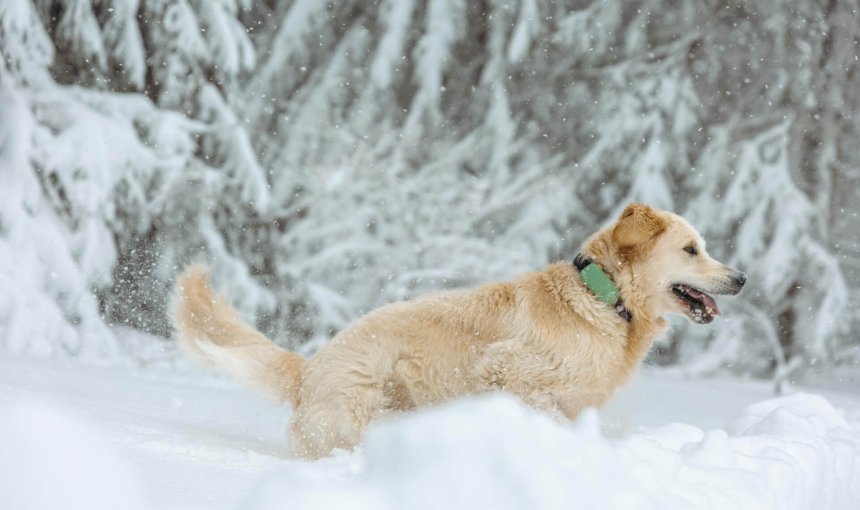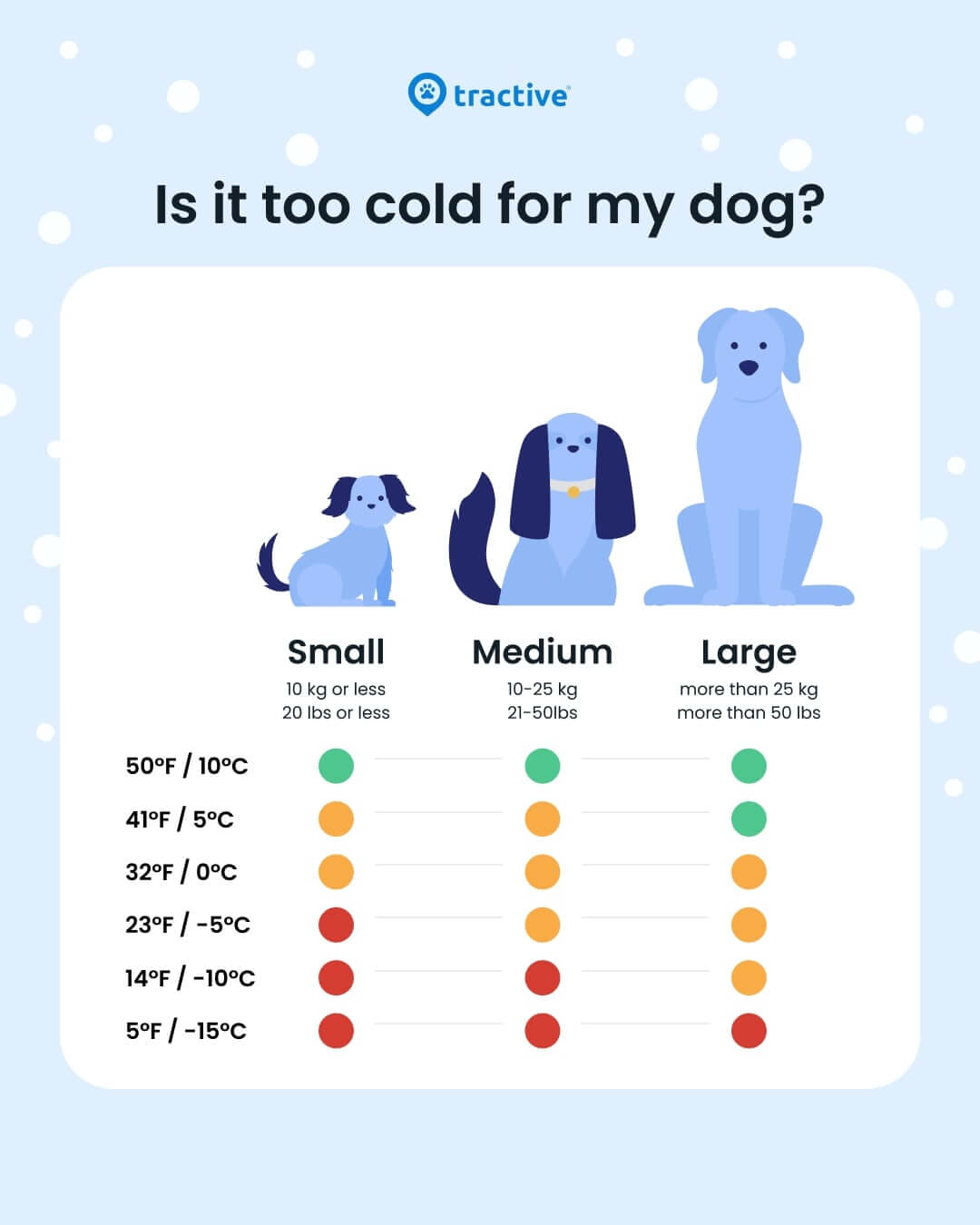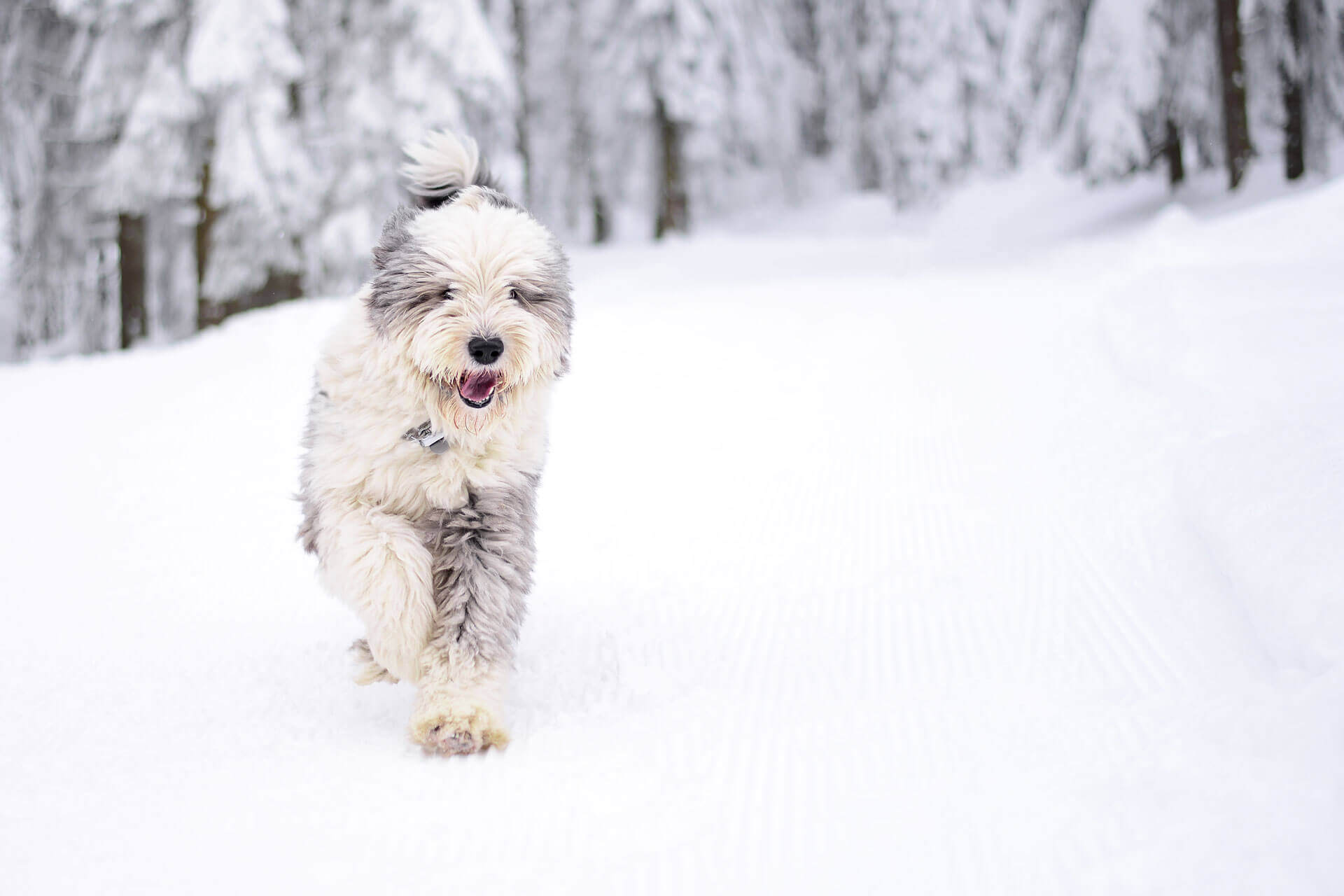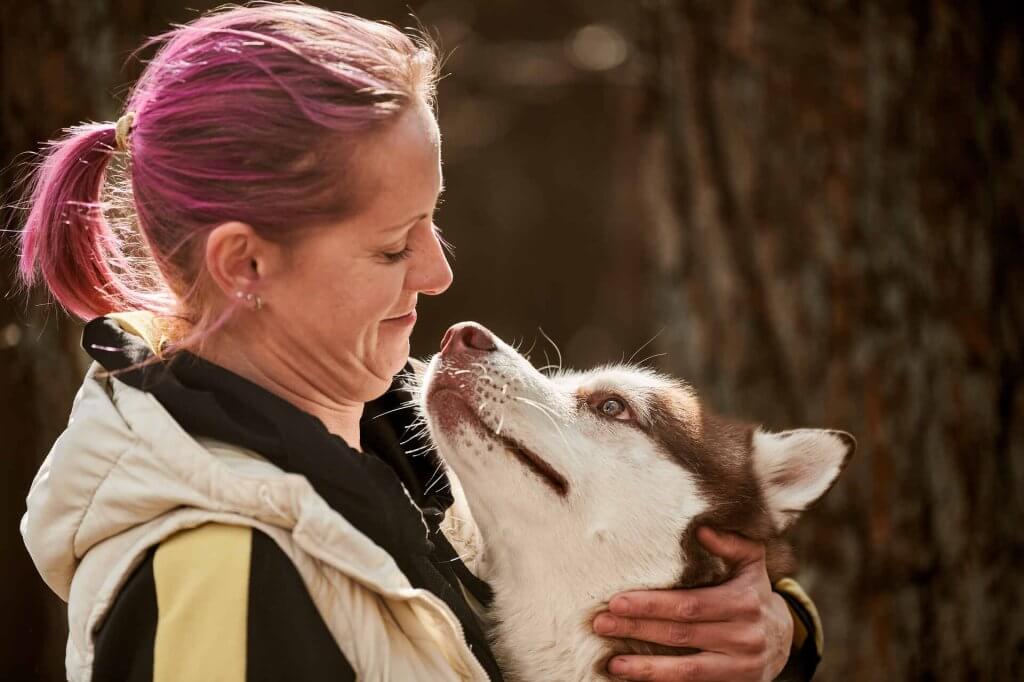 Approved by Dr. Dwight Alleyne, DVM
Approved by Dr. Dwight Alleyne, DVM How Cold Is Too Cold For Dogs?
Do dogs get cold? Learn the signs, temperature dangers below 45°F, and winter safety tips to protect your pup - plus why cold weather increases lost pet risk.

Picture this: It’s a crisp winter morning, and while you’re bundled up in layers, your furry best friend is bouncing through the snow with nothing but their natural coat. So of course you may wonder— do dogs get cold? And how cold is too cold for dogs? With the right knowledge and cold weather precautions, you and your four-legged friend can safely enjoy all the magic winter has to offer. So let’s dive into everything you need to know about keeping your dog warm, healthy, and happy when the temperature drops.
Key Takeaways
- Dogs do get cold – Many feel uncomfortable below 45°F (7°C), with small dogs at higher risk
- Temperature danger zones – Below 32°F (0°C) requires limited outdoor time; below 20°F (-7°C) risks hypothermia.
- Warning signs – Shivering, lifted paws, whining, lethargy, seeking warmth.
- Normal body temperature – Healthy dogs range from 99.5 to 102.5°F (38.3 to 39.2°C)
- Winter increases lost pet risk – A GPS dog tracker can be a lifesaver.

Always know your buddy is healthy & safe
Read moreDo dogs get cold?
Yes, dogs do get cold! Just like us humans, dogs can experience cold-related discomfort and even dangerous conditions like hypothermia if exposed to freezing temperatures for too long. Signs your dog is feeling cold include shivering or shaking, whining, seeking warm spots near heaters, tucking their tail, and showing reluctance to go outside.
Small breeds, puppies, senior dogs, and those with thin coats are especially vulnerable to cold weather. Even cold-weather breeds like Huskies have their limits! So if you notice your pup shivering, immediately bring them indoors and warm them up gradually. Remember – if it’s too cold for you, it’s probably too cold for your four-legged friend.
How cold is too cold for dogs?
There’s no one answer to the question – how cold is too cold for dogs. Rather, different dogs tolerate cold temperatures differently. Some dogs love snow and cold weather, while others get cold very easily and can not stay outside in the cold for very long.
As a general rule of thumb:
- at 45°F (7°C) and below, most dogs will dogs will start to become uncomfortable
- at 32°F (0°C) and below, small, thin-coated, young, old and sick dogs should not be left outside for long
- at 20°F (-7°C) and below, dogs become vulnerable to hypothermia and frostbite1
But in general, your dog’s ability to withstand the cold depends on factors like their:
- Breed
- Size
- Body fat
- Fur
- Overall health and medical condition and
- whether they’re an indoor or outdoor dog
When is it too cold for my dog?
In general, you can use your dog’s size to determine how cold is too cold for them, using the table or graphic below:
| Temp. | Small Dogs 10kg (20lb) or less | Medium Dogs 10-25kg or 21-50lbs | Large Dogs Over 25kg (50lbs) |
|---|---|---|---|
| 50°F / 10°C | 🟢 | 🟢 | 🟢 |
| 41°F / 5°C | 🟡 | 🟡 | 🟢 |
| 32°F / 0°C | 🟡 | 🟡 | 🟡 |
| 23°F / -5°C | 🔴 | 🟡 | 🟡 |
| 14°F / -10°C | 🔴 | 🔴 | 🟡 |
| 5°F / -15°C | 🔴 | 🔴 | 🔴 |
🟢 At these temperatures, it’s generally considered safe for most dogs.
🟡 Exercise caution and limit cold exposure at these temperatures.
🔴 Better to keep your dog indoors at these temperatures.

⚠️ Keep in mind: These are general guidelines only. Your dog’s cold tolerance depends on their size, age, health, coat type, and individual preferences. Wind, rain, and dampness make temperatures feel colder. Always monitor your dog for signs of discomfort (shivering, whining, seeking warmth) regardless of the temperature. When in doubt, bring them inside. Consult your vet for personalized advice.
Which dogs are sensitive to cold weather?
Dog breed and health are big factors when it comes to risk of freezing. The following dogs are considered especially sensitive to cold temperatures. In other words, we need to take extra care of these vulnerable dogs and make sure they keep warm in the cold winter months:
- small dogs
- short-haired and hairless dogs
- puppies
- senior dogs
- indoors ‘pet’ dogs
- dogs with a medical or heart condition
- dogs with arthritis and joint problems
- Dobermen, Boxers and Greyhounds
All dogs are vulnerable to cold weather
To some degree, all dogs are vulnerable to the cold. Paws, nose, ears and the stomach region are generally unprotected and therefore quite sensitive in all dogs. So make sure your dog’s paws are properly maintained, for example, by applying a paw balm before going for a short walk outside and by removing the dirt when returning home.
Signs that your dog is too cold
As soon as your dog begins to tremble, they are already too cold. When your dog starts to freeze or become too cold, they may:
- shiver or tremble
- lift paws off the ground
- look or feel unwell
- move slowly or be reluctant to walk
- take a cramped posture or tuck their tail
- cuddle on your leg or on another heat source
- show anxious or restless behavior
Be careful not to leave your dog outside in cold temperatures for too long, otherwise they may catch a cold.

Get health alerts for your dog
Our pups can’t always tell us if something’s wrong. But if their tracker detects unusual changes in their routine, you’ll get an alert, helping you catch potential issues early.
What is a normal temperature for a dog?
Knowing your dog’s normal body temperature is crucial for winter safety. A dog’s normal body temperature ranges from 99.5 to 102.5°F (38.3 to 39.2°C), which is significantly warmer than the human average of 98.6°F. Temperatures below 99°F or above 104°F require immediate veterinary attention. Unlike humans who sweat to cool down, dogs rely primarily on panting to regulate their body temperature, making them more vulnerable to both overheating and cold exposure. If your furry friend has been outside in the cold and feels unusually cold to the touch, it’s worth monitoring their temperature closely.
⚠️ Don’t forget to dry your dog thoroughly after being outside in the cold weather so they can quickly get back to their normal body temperature.
Hypothermia in dogs
If your dog is exposed to low temperatures for longer periods of time, they could also suffer from hypothermia. This can be experienced locally, for example, freezing ears or paws. An overall hypothermia of the body can cause deep organ damage and even be deadly. Signs of severe hypothermia include tight and dilated pupils, difficulty in breathing and even coma. Read more on hypothermia in dogs.
How to keep dogs warm in winter
To keep dogs warm in winter and protect them from cold or freezing, we recommend the following:
- Limit the time your dog has to spend outdoors in winter’s cold temperatures.
- Keep dogs who are sensitive to cold indoors, except for short potty breaks.
- Equip your dog with a weatherproof dog jacket for winter or suitable dog boots.
- Keep walks short, and keep your furry friend moving.
- Dry your dog as soon as possible, in case they get wet in cold temperatures.
- Make sure your dog has a warm, clean, and cozy place to sleep.

Don’t let your dog get lost in the cold
Did you know winter is the most dangerous season for lost pets? The combination of disorienting snow, reduced visibility, and shorter daylight hours creates a perfect storm for dogs to go missing. And when temperatures drop below freezing, a lost dog situation becomes a race against time.
Why winter increases your dog’s risk of getting lost
Snow disrupts your dog’s natural navigation system1. While dogs can normally track scents up to 12 miles away, heavy snowfall acts like a blanket that muffles familiar smells. Think of it as nature’s way of “resetting” all the scent markers your dog uses to find their way home.
Here’s what makes winter especially risky:
- ❄️ Fresh snow covers familiar scent trails within minutes
- 🌨️ Wind and storms scatter scents in unpredictable directions
- 🐕 Excited dogs chase snowflakes or wildlife and lose their bearings
- 🌙 Early darkness means less visibility for both you and your pup
- 🥶 Cold temperatures make survival critical within hours, not days
The hidden danger: winter disorientation
Even the most well-behaved dogs can experience “snow zoomies” – that burst of excitement when they see fresh powder. Combine this with:
- puppies who haven’t mastered recall
- rescue dogs still learning boundaries
- any dog spooked by snow plows or ice falling from trees
…and you have a recipe for an unexpected chase through the neighborhood.
Peace of mind in any weather
This is why winter-proofing your dog’s safety goes beyond warm coats and paw protection. A microchip provides permanent ID, but it only works after someone finds your dog. For real-time peace of mind, pair it with a smart GPS & health tracker for dogs that lets you:
- See exactly where your dog is, even in a blizzard
- Get instant alerts if they leave your yard
- Track them through snow-covered areas where visibility is poor
- Monitor their health, activity and vital signs to ensure they’re moving and staying warm
Remember: In freezing conditions, every second counts. The faster you can locate your lost dog, the better their chances of avoiding hypothermia, frostbite, or worse.

Tractive saved my dog’s life!
This tracker saved my dogs life yesterday! If you’re on the fence — don’t hesitate and get this tracker. It showed me exactly where my dogs were — my little girl had fallen through the ice.
If it wasn’t for Tractive I wouldn’t have gotten to her in time and saved her life.
Ready to brave the winter with your best friend?
Now you know the answer: yes, dogs do get cold, and temperatures below 45°F can pose real risks to your furry friend. But winter doesn’t have to mean hibernation! Armed with the right knowledge, you and your pup can safely enjoy every snowy adventure together.
Your dog winter safety checklist ✓
Remember these key takeaways:
- Know your dog’s limits – size, age, and breed all matter
- Watch for warning signs – shivering means it’s time to head inside
- Layer up wisely – invest in proper winter gear for sensitive pups
- Keep adventures short but active – movement generates warmth
- Protect those paws – salt, ice, and cold surfaces can cause damage
- Stay visible and findable – winter’s early darkness and snow create unique risks
The bottom line
Every dog is unique, and you know yours best. Trust your instincts – if you’re cold, they probably are too. When in doubt, choose warmth and safety over extended outdoor time. After all, the best part of a winter walk is coming home to cuddle up together!
Don’t let winter weather catch you unprepared. Whether you’re planning snowy hikes or just quick potty breaks, make sure your dog is protected from both cold temperatures AND the increased risk of getting lost. Because the only thing worse than a cold dog is a cold, lost dog.
Explore more winter resources
Keep your winter adventures safe and fun with these helpful guides:
- 8 Essential Winter Dog Safety Tips
- Dog-Friendly Winter Activities That’ll Tire Them Out
- Can Dogs Catch a Cold? What You Need to Know
Have a winter safety tip to share? Tag us @tractive on social media – we love seeing how you keep your furry friends warm and happy!
Your furry friend’s health and wellbeing means as much as to us as it does to you. So we’ve made it a priority to only share medically-relevant content on our blog. This post was checked, double-checked, and medically verified by Georgia-based vet, Dr. Dwight Alleyne.

Dr. Dwight Alleyne, DVM
Originally from Long Island, New York, Dr. Alleyne began his career at a no-kill animal shelter before becoming a licensed veterinary technician. He graduated from Cornell University Veterinary College in 2006 and completed an internship at Purdue University. Now practicing in Georgia, Dr. Alleyne specializes in soft tissue surgery and ultrasounds. He also writes pet health articles on his website, “The Animal Doctor Blog” (www.anmldrblog.com).




